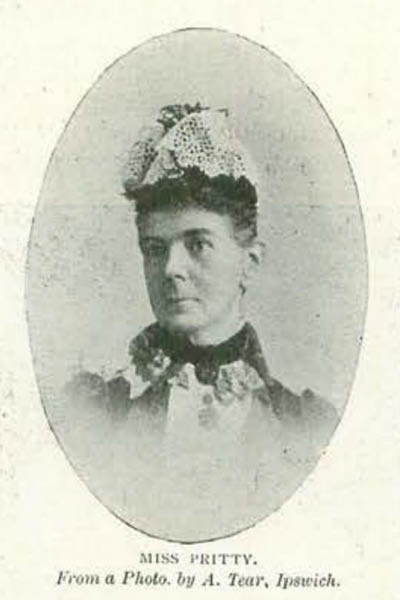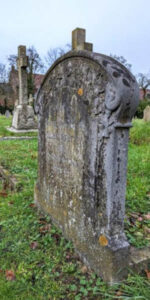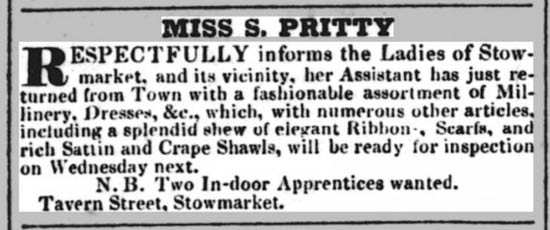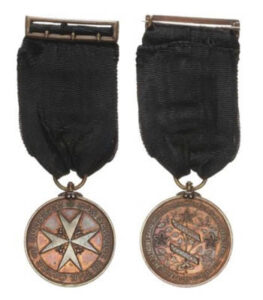This story is one of the winning stories in the 20sStreets competition. The competition invited entrants to research and share stories of the 1920s, searching for the most fascinating local history stories covered by the 1921 Census of England and Wales. There were six winning stories and twelve runners-up entries.
Well, well, well: The story of a Suffolk heroine
By Elizabeth Walne, runner-up (one of ten) in the Individual category

Photograph of Miss Pritty, c.1901 Strand Magazine. Photographer: A.Tear Ipswich
Sometimes in life, you just have to get in the damn bucket and do it yourself…
The 1920s might be best remembered in popular culture for Bright Young Things, but a good proportion of 20Streets properties were occupied by people who had spent decades as Victorians. In their own ways, the women among them had paved the way for their 1920s successors to gain greater freedoms.
One such woman – one such ‘weaker vessel’ in the parlance of the local newspaper [1] – was Miss Ellen Pritty, who, in 1921, was living in Cretingham, Suffolk. On the schedule, she described herself as a spinster and a housekeeper working at home. [2] We know from other sources that she looked after ‘paying guests’ who needed some support.[3]
From the records left behind, it might be suggested that Miss Pritty liked things done properly – and that she was prepared to do things herself if necessary!
Beginning at the end

Ellen Pritty’s headstone at Framlingham Cemetery
On a surprisingly warm day in October 1926, family and friends stood at a graveside in Framlingham to watch Miss Pritty’s coffin lowered into the ground. [4] Ellen was 83 when she died, had never married nor had children. [5]
Ellen had lived in Kelsale during the final years of her life. [6] Her final home was, in common with her previous one, neat, symmetrical, respectable, and suitable for a 1920s woman of independent means. [i]
A picture from that time depicts Ellen sitting in her garden, a white-haired lady in a shawl and cap reading quietly. Several young people were lined up around her because, while technically childless, Ellen was nonetheless a matriarch with a large extended family.[7]
A picture may speak a thousand words, but this one hides thousands more – for Ellen was not an old lady that had lived an entirely quiet and uneventful life in rural Suffolk.
Ellen’s upbringing
We might view Ellen today as a self-made woman, albeit one who had some advantages in her early life.
Born in 1843, Ellen entered the world as the fifth daughter of farmer George Pritty and his wife, Elizabeth. [8] By 1851, Ellen was the fifth of seven consecutive daughters, but her mother had finally produced two boys in positions eight and nine. [9] Eventually, Ellen became one of eleven. [10]
Ellen and her sisters didn’t grow up and marry local farmers’ sons in their turn. In fact, only two of the eight Pritty sisters ever married at all. [11] Perhaps watching their mother endure at least nine pregnancies in ten years had put them off the idea of marriage and babies, or perhaps there was relative hardship when their father died, pushing them into paid work instead of domesticity. [12]
The extended Pritty family were in drapery and dressmaking, and a live-in teacher educated the children. [13] As a result of this ready-made network, almost all the Pritty sisters became shop assistants at drapers’, including Ellen herself, who was a ‘shop maid’ as a teenager. [14]

Suffolk chronicle, 1833. Miss S Pritty. 9 November 1833. via britishnewspaperarchive
Striking out
By 1871, Ellen was in Devon, living within Higher Terrace, Torquay, a nurse working for Cordelia Mott, a woman of significant means. [15]
Frustratingly, the 1881 census has not yet revealed Ellen’s whereabouts, despite an extensive search. Ellen’s former mistress, however, died in Paris. [16] Is it possible Ellen was abroad for the census? Either way, she returned to Suffolk in time for the 1891 count, now retired from a senior position in a household, experienced in the ways of those of high rank, and set up as the mistress of her own abode. [17]
Cretingham
Before she moved to Kelsale, Ellen had lived 13 miles west in Cretingham. There, she resided in a rather larger home with a pretty porch flanked by Georgian windows and perfectly positioned chimneys on either end of the roof.
Perhaps it’s telling that in 1891, somewhat irregularly, Ellen was enumerated as the head of household, a retired housekeeper, while her brother was runner-up on the schedule. The pair had two live-in servants, as many as anybody else in the village. [18]
In the fragments available, Ellen comes across as a purposeful woman with a keen sense of duty. We know, for example, that she organised a message to the new King expressing sympathy at the death of Queen Victoria on behalf of 87 Cretingham parishioners. [19] Later, she wrote to the Guardians to demand that a local couple receive support from their sons as well as relief, and, later still, she got involved in the sale of a village fire engine! [20]
By 1900, Ellen, now in her 50s, had a new project: she decided she needed a well. Hearing of a local man possessing ‘wonderful powers’ with a divining rod, she entreated him to bring his hazel twigs to Cretingham, where they apparently exhibited ‘extraordinary animation’. Confident in the diviner’s assertions, Ellen organised the digging of a new well and -concurrently – the filling of her pond, from which her water had previously been supplied. [21]
Tragedy and heroism
On a hot August Friday morning, Ellen heard a furore in her garden. It was 10.30 am, and James Harry Mann, a local builder in his thirties, [ii] had descended 48 feet into the (still dry) well under construction. A while later, workmen at the top heard Mann groan. [22] They called for help. In fact, they panicked, pointing wildly at the well, frantically shouting, ‘he’s dead, he’s dead’! [23]
Ellen came charging out of the house, armed with brandy. Quickly grasping that the workmen in her company dared not go down the well themselves, she promptly got herself into the workmen’s bucket and demanded to be let down by rope.
Arriving at the bottom, Ellen found Mann flat on his back. She pulled his shirt open, rubbed his chest and lifted his head, but it was already too late; the poor man had gone. In her own words:
“He was cold as marble. I poured some brandy down his throat, and tried to restore animation by rubbing him, but without success.” [24]
Not long after her descent, the men at the surface pulled Ellen back up, blinking into the sunlight – a necessarily quick endeavour as she too could have suffocated in the well. [iii]
“I sat down on a log of wood nearby, but I could not get the sight of the poor man out of my mind…I was very ill in the evening [from the noxious gases], but thank God, I’ve been spared.” [25]
It took three hours for conditions deep in the well to be deemed safe enough to retrieve Mann’s body. He left a young widow and a little boy. [iv]
The aftermath
“Miss Pritty is just the sort of lady one would expect to act promptly in an emergency, and perform a brave deed. Tall, with slightly knit brows, searching eyes, and firmly-pressed lips, her features at once suggest strength of will and force of character. She readily consented to describe her adventure, but it could easily be seen that she wished to take as little credit as possible.” [26] [27]
The press picked up the story, and after it appeared in The Ipswich Journal, it spread rapidly across the country.
On 9 November 1900, Ellen’s neighbours presented her with £6 17s to buy a piece of plate. The great and the good signed the accompanying testimonial, including Lord Tollemache. [28] The presentation was also picked up by several newspapers, even if Ellen was referred to as a ‘plucky girl’ called Helen in several of them! [29]
The Empire News bucked the trend for duplication and reported that – while Ellen was noble –
‘[the] incident is disappointing. Her fellow villagers presented Miss Pritty with a purse of gold, but they never thought of ducking the three cowards [at the top] in the horsepond”! [30]

Photograph of Ellen Pritty’s Order of St John of Jerusalem Medal. Sold in 2014 as ‘life saving medal’ named on edge to Sir Ellen Pritty.
Two further commendations followed for Ellen: an award from the Royal Humane Society [31] and a bronze medal for great gallantry and presence of mind from the Order of the Hospital of St John of Jerusalem, presented by the new King himself in July 1901. [32]
As for the well? It remained dry – as did a second dug immediately afterwards. Litigation against the diviner followed, [33] and Ellen even advertised her home for sale ‘in consequence of expenditure through sinking two wells and no water’. [34] Whether she ever had any intention of selling is debatable. Alas, there is little space to digress except to say that, eventually, she was awarded £42 in damages. [35]
A woman on a 20sStreet
Ellen didn’t leave Cretingham until after the 1921 census, even after the tragic loss of one of her boarders. [36] Another boarder lived with her in both Cretingham and Kelsale for a total of more than twenty years, but both he and Ellen died long before a piped water supply arrived in Cretingham after the Second World War.[37]
One of the medals worn by the woman on this 20sStreet was auctioned in Australia in 2014, smashing its estimate. [38]
Apt, perhaps, given the heroine herself smashed society’s estimation of the ‘weaker vessel’ and ‘gentler sex’ 100 years ago. [39]
Notes:
i: Both of Ellen’s homes still stand and have the same names; I have not named them for this reason
ii: This initial local reporting was incorrect and named him ‘Harryman’. Later, newspapers did refer to ‘Mann’,
but often gave him the first name Charles.
iii: It seems likely the poisonous gas was hydrogen sulphide, created by sulphur-reducing bacteria in anaerobic
atmospheres – the gas that gives off a ‘rotten egg’ smell.
iv: Eliza and William Pritty
Sources:
1 The full sentence says ‘many instances are on record of bravery and pluck on the part of those men
sometimes call “the weaker vessel” so the newspaper is speaking indirectly. The Ipswich Journal. (1900) Suffolk
Woman’s Heroic Deed. 11 August 1900. p. 6. Accessed online: britishnewspaperarchive.co.uk.
2 1921 Census. England. Cretingham, Suffolk. 19 June 1921. Pritty, Ellen. RG 15/9477, ED 1 & 2, Sch 49.
Accessed online: findmypast.co.uk.
3 The term ‘paying guest’ comes from a newspaper article about an inquest where Miss Pritty described her
relationship with a woman who lived with her, the daughter of a well-off family released from Ipswich
Borough Asylum. East Anglian Daily Times. (1902) Lady’s Suicide at Cretingham. 14 October 1902. P. 3.
Accessed online: britishnewspaperarchive.co.uk.
4 Framlingham Town Council. (2021) Cemetery Searcher. Pritty, Ellen. Grave Number: RE5. Accessed online:
https://cemeterysearcher.co.uk/search/framlingham.
5 Deaths Index (Civil Registration). England & Wales. Blything Registration District [Suffolk]. December Quarter,
1926. Pritty, Ellen. Volume 4a, p. 1115. Accessed online: ancestry.co.uk.
6 Death: Testamentary records. England. 13 November 1926. Pritty, Ellen. Ipswich Probate Registry [Suffolk].
Calendar of the grants of probate. p. 712. Collection: England & Wales, National Probate Calendar, 1858-1966.
Accessed online: https://ancestry.co.uk.
7 I do not currently have permission to include this photograph in this story. Her status in the family is evident
in a multitude of family photographs posted by relatives on ancestry.co.uk.
8 Births Index (Civil Registration). England & Wales. Stow Registration District [Suffolk]. September Quarter,
1843. Pritty, Ellen. Volume 12, p. 415. Accessed online: https://gro.gov.uk; Baptisms (Parish Registers) England.
Haughley, Suffolk [spelt Hawleigh on transcription]. 1 December 1844. Pritty, Ellen. Collection: England &
Wales, Christening Index, 1530-1980. Accessed online: https://ancestry.co.uk.
9 1851 Census. England. Haughley, Suffolk. 30 March 1851. Pritty, Ellen. HO107/1794. Folio 736. ED 9c. p. 15.
SN 49. Accessed online: https://ancestry.co.uk.
10 Calculated from an extensive search of GRO birth indexes and cross-referenced with census and baptism
data. This would not usually include any stillbirths or miscarriages.
11 I have researched all of Ellen’s siblings but have not listed all the many sources here. Please contact me for
further details.
12 Deaths Index (Civil Registration). England & Wales. Stow Registration District [Suffolk]. December Quarter,
1859. Pritty, George. Volume 4a, p. 325. Accessed online: ancestry.co.uk.
13 1851 Census. England. Haughley, Suffolk. 30 March 1851. Pritty, Ellen. HO107/1794. Folio 736. ED 9c. p. 15.
SN 49. Accessed online: https://ancestry.co.uk; for Pritty family drapers and dressmaking, please see
britishnewspaperarchive.co.uk and contemporary trade directories for many search results. Figure 1: Images.
Newspaper Screenshot. Suffolk Chronicle (1833) Miss S Pritty. 9 November 1833. P. 2. Accessed online:
britishnewspaperarchive.co.uk.
14 1861 Census. England. Wetherden, Suffolk. 7 April 1861. Pretty, Ellen (sic). RG 9/1145. Folio 166. ED 15. p.
12. SN 36. Accessed online: https://ancestry.co.uk
15 1871 Census. England. Tormonham, Torquay, Devon. 2 April 1871. Chandler, Edwin Nunn. RG10/2088. Folio
63. ED 13. p. 55. SN 278. Accessed online: https://ancestry.co.uk; Images. Photograph. Cordelia Euphemia
Mott’. 1860s. Italy? Fratelli D’alessandri, photographer. National Portrait Gallery, London. Collection: UK,
Portraits and Photographs, 1547-2018. Accessed online:
https://ancestry.co.uk; The census schedule notes ‘Nurse to M Mott’. At first glance, this might suggest Ellen
was nurse to Cordelia’s young daughter, but knowing what we do about Ellen’s later life, I’m not so sure. It’s
possible she was nurse to her mistress who died only months later.
16 Deaths. France. 20 June 1872. Mott, Cordelia Euphemia. Paris. Entry No 538. Collection: Paris, France,
Births, Marriages, and Deaths, 1680-1930. Accessed online: https://ancestry.co.uk
17 1891 Census. England. Cretingham, Suffolk. 5 April 1891. Pritty, Ellen. RG12/1479. Folio 30. ED 3. p. 1. SN 5.
Accessed online: https://ancestry.co.uk.
18 Ibid. Servant numbers have been compared across the entire parish.
19 East Anglian Daily Times. (1901) East Anglia. 8 March 1901. P. 7. Accessed online:
britishnewspaperarchive.co.uk
20 Framlingham Weekly News. (1906) Cretingham Ratepayer’s Complaint. 3 November 1906. P. 4 Accessed
online: britishnewspaperarchive.co.uk; East Anglian Daily Times. (1905) Ancient Fire Engines. 14 October 1905.
P. 7. Accessed online: britishnewspaperarchive.co.uk
21 The Ipswich Journal. (1900) Why the well was dug: a divining rod story. 11 August 1900. p. 6. Accessed
online: britishnewspaperarchive.co.uk.
22 One letter to the press suggests it was not a few moments and that the men at the top were distracted by
ploughing in neighbouring fields: The Ipswich Journal. (1900) The well-boring experiments at Cretingham –
Correspondence 24 November 1900. p. 7. Accessed online: britishnewspaperarchive.co.uk.
23 The Ipswich Journal. (1900) Suffolk Woman’s Heroic Deed. 11 August 1900. p. 6. Accessed online:
britishnewspaperarchive.co.uk.
24 ibid
25 Although most accounts agree Miss Pritty was ‘quite exhausted’, unwell, or even ‘more dead than alive’, one
letter to the local newspaper suggests she was unconscious herself: The Ipswich Journal. (1900) The wellboring experiments at Cretingham – correspondence. 24 November 1900. p. 7. Accessed online:
britishnewspaperarchive.co.uk.
26 The Ipswich Journal. (1900) Suffolk Woman’s Heroic Deed. 11 August 1900. p. 6. Accessed online:
britishnewspaperarchive.co.uk.
27 https://www.victorianvoices.net/ARTICLES/STRAND/1900B/S1900B-Heroes.pdf
28 A full list of signatories can be found in newspaper articles e.g.: The Ipswich Journal. (1900) Recognition of
Miss Pritty’s Bravery. 17 November 1900. p. 7. Accessed online: britishnewspaperarchive.co.uk
29 See, for example: Morning Post. (1900) Girl’s Heroism. 16 November 1900. p. 5. Accessed online:
britishnewspaperarchive.co.uk.
30 Empire News & The Umpire. (1900) The Light of Truth. 18 November 1900. p. 1. Accessed online:
britishnewspaperarchive.co.uk.
31 Stamford Mercury. (1900) Brave Ladies Rewarded. 23 November 1900. P. 3. Accessed online:
britishnewspaperarchive.co.uk.
32 The Nursing Record and Hospital World. (1901). London. Ed: Mrs Bedford Fenwick. P. 74. Accessed online:
https://rcnarchive.rcn.org.uk/volumes/27/Volume%2027%20Page%2074; Biggleswade Chronicle. (1901)
Heroes and the King. 19 July 1901. P. 2. Accessed online: britishnewspaperarchive.co.uk.
33 Ipswich Journal. (1900) The Water-Divining Experiments. 17 November 1900. p. 3; Ipswich Journal. (1900)
The Well-Boring Experiments at Cretingham. 24 November 1900. P. 7. Both accessed online:
britishnewspaperarchive.co.uk.
34 East Anglian Daily Times. (1901) FOR SALE. 7 March 1901 p. 6. Accessed online:
britishnewspaperarchive.co.uk.
35 Yorkshire Evening Post. (1902) Miss Pritty and the Water-Diviner. 21 March 1902. p. 4. Accessed online:
britishnewspaperarchive.co.uk.
36 Framlingham Weekly News. (1902) Lady’s Tragic Death at Cretingham. 18 October 1902. p. 4. Accessed
online: britishnewspaperarchive.co.uk.
37 Diss Express. (1949) Water Supply at Cretingham. 5 August 1949. P. 5. Accessed online:
britishnewspaperarchive.co.uk.
38 Noble Numismatics Pty Ltd. 2014. ORDER OF ST JOHN OF JERUSALEM BRONZE LIFE SAVING MEDAL, (type 2)
named on edge to Miss Ellen Pritty 1901. Auction date: 20 November 2014. Lot No: 4346. Available online:
https://www.noble.com.au/auctions/lot?id=331845.
39 The Strand Magazine. (1900 or 1901) Peace Heroes of 1900 by Alfred T. Storey. P. 645. Collection: Victorian
Voices, compiled by Moira Allen. Available online:
https://www.victorianvoices.net/ARTICLES/STRAND/1900B/S1900B-Heroes.pdf.